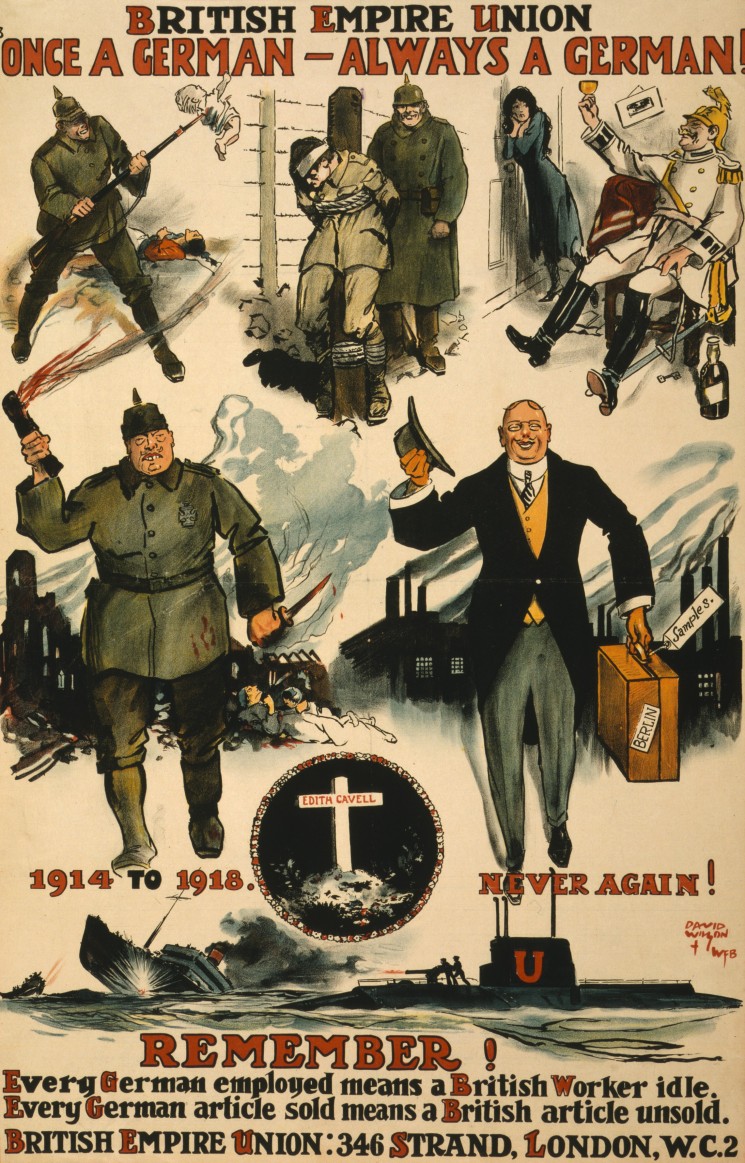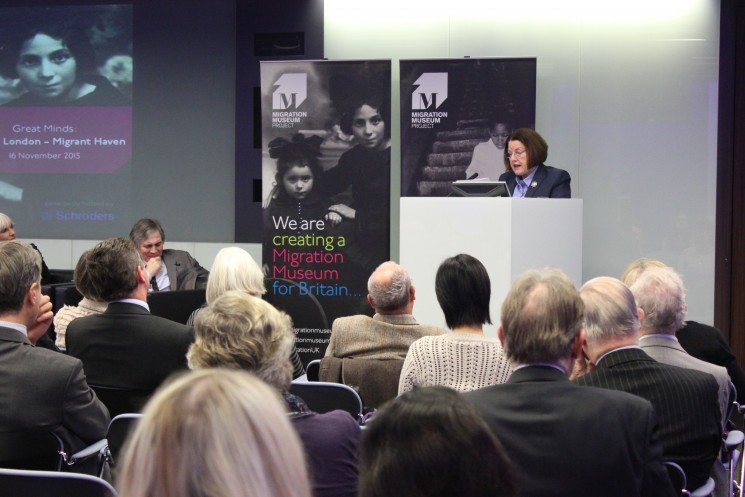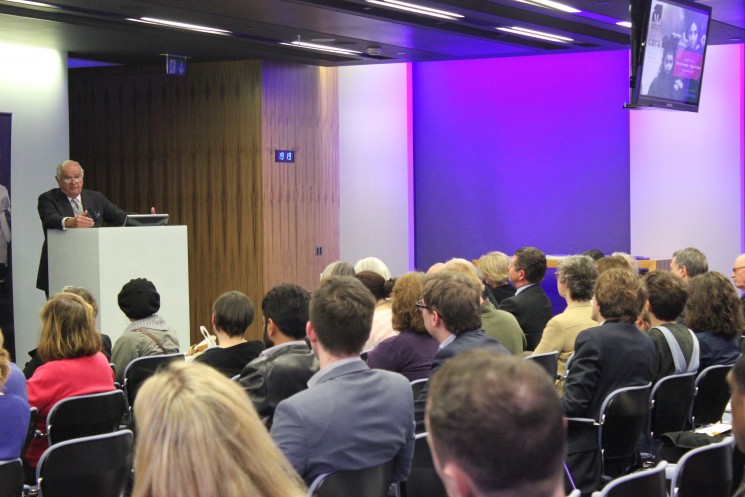City of London: Migrant Haven

The four panellists for ‘Migrant Haven’ (l to r): Stanislas Yassukovich, Kathleen Burk, Caroline Shaw and David Kynaston
What contribution have migrants made to the City of London, the financial powerhouse of the United Kingdom? And what role do they continue to play in shaping London’s financial institutions?
These questions were the focus of our latest Great Minds event, City of London: Migrant Haven, hosted by Schroders on 16 November 2015. The event chaired by eminent historian David Kynaston featured historical and personal perspectives on migrants who have left their mark on the City from the 17th century to the present day. The panel of speakers consisted of Caroline Shaw, Archivist at the Schroder Archive; Kathleen Burk, Professor of Modern and Contemporary History at University College London; and Stanislas Yassukovich, widely regarded as one of the architects of the international capital market and previously CEO at European Banking Group.
18th and 19th Century City of London
David Kynaston, author of the four-volume series The City of London, highlighted that the City has always been open to people coming from abroad to work, but that migration truly picked up pace in the late 17th century. This is reflected in the history of the Bank of England, a quarter of whose original board of directors at its founding in 1694 were of Huguenot heritage – including the first Governor of the Bank, John Houblon.

Sir John Houblon was a Huguenot who served as the first Governor of the Bank of England
By the early 18th century, the City of London was a visibly cosmopolitan financial capital. Joseph Addison wrote in The Spectator in 1711,
THERE is no place in the town which I so much love to frequent as the Royal Exchange. It gives me a secret satisfaction, and in some measure, gratifies my vanity, as I am an Englishman, to see so rich an assembly of countrymen and foreigners consulting together upon the private business of mankind, and making this metropolis a kind of emporium for the whole earth … sometimes I am justled among a body of Armenians: sometimes I am lost in a crowd of Jews; and sometimes make one in a group of Dutchmen. I am a Dane, Swede, or Frenchman at different times; or rather fancy myself like the old philosopher, who upon being asked what countryman he was, replied, that he was a citizen of the world.
According to David Kynaston, the 19th century City of London owes much to three game changers, all of them German Jewish immigrants: Nathan Rothschild, Ernest Cassel and Siegmund Warburg. The latter was instrumental in the development of the Eurobond, which marked the City’s revival as international financial centre. Commenting on the overwhelming internationalism in Canary Wharf today, Kynaston also left us with a provocative question about a potential downside to all this migration:
Has there been a ‘Wimbledon-isation’ of the City, i.e. rather like the tennis tournament, we provide the venue but we no longer provide the champions?
The German Connection
Caroline Shaw, Archivist at the Schroder Archive, explored the contributions of the Hanseatic Schroder family to the UK banking system in the 19th and 20th centuries. Schroders was founded in London by two brothers, Johann Friedrich and Johann Heinrich Schroder, in the early 1800s and their strong links to Germany were a significant factor in the firm’s early development. But, by the mid-19th century, the firm diversified into areas – including bond issuing and, more interestingly, taking on agency for the distribution of Peruvian guano – that were less dependent on the German connection and made it one of the most prominent merchant banks in the City.
The First World War brought the ‘nationality’ of the firm into question – the senior partner of the firm, Baron Bruno, was in immediate danger of internment as an enemy alien and the firm in imminent danger of seizure as enemy property. Not only that, but £4 million, more than the firm’s entire capital, was tied up in obligations accepted on behalf of German and Austrian clients.

The outbreak of the First World War brought the German origins of Schroders into sharp relief.
Schroders was deemed ‘too big to fail’, and the Bank of England lobbied intensively to save the firm. Despite the anti-German sentiment of the war years, Schroders had by that point “entered into the City’s cosmopolitan embrace, and was part of the City’s flows of commerce and capital”. As Caroline Shaw argued,
[Schroders] may indeed have been ‘too big to fail’ but I think we can also usefully see it as having been ‘too integrated to fail’.
Era of American Dominance
Kathleen Burk identified the deregulation of financial markets under the Thatcher government – also known as Big Bang – as the moment in history that opened up an era of dominance of American firms in the City. This had a profound effect on the working culture of the City, leading to longer work hours, shorter lunches and shakier marriages! The Americans were also instrumental in supplanting relationship banking with transactional banking (although the former did not completely disappear) and upending specialisation in markets and financial products with one-stop banking supermarkets.
The aggressive expansion of American business in London required more space for trading rooms and offices, leading first to the building of Broadgate in the mid-1980s, followed by the development of Canary Wharf – the consequence of which being that a large chunk of the City is now outside the City. Finally, Professor Burk argued that the American dominance emphasised, and accelerated, the position of the City of London as separate from the rest of the country, always looking outwards to ensure its survival. With the economic decline of the UK in the 20th century there was a danger that New York would take over. However, the Eurodollar market attracted American money in huge quantities so that, while New York City remains the financial capital of the United States, the City of London, partly due to its dominance in foreign exchange, is now the financial capital of the world.

Kathleen Burk on the American influence: “It could be argued that the influx of American firms, American money, and American business culture saved the City’s bacon.”
A Cosmopolitan Capital
Stanislas Yassukovich, a veteran of the Eurobond market who started in the City in 1961, spoke of his family’s personal experiences in London. He recalled that his Russian émigré father marvelled at the cosmopolitanism of the City of London in the first half of the 20th century. He credits this cosmopolitan culture as a significant reason why London was able to surpass Paris and Amsterdam as the financial capital of the world. Those cities were much more insular, whereas London not only welcomed individuals and skills but also integrated the cultures and ethos of migrants into the City. “Immigration is a key factor to London’s success,” said Yassukovich. He also acknowledged the changing nature of the City and particularly the erosion of its village-like feel, which has historically also made the City cohesive and successful.

Stanislas Yassukovich considers the characteristics that allowed the City of London to thrive.
The panel also engaged in a lively question-and-answer session with the audience that touched on topics such as migrants’ reception outside the City in the places they lived and the UK’s relationship to the EU. At a time when migration is a constant feature in the news, the panel discussion illuminated the long and continuing history of migrants’ contributions to London’s thriving financial institutions.


Leave a Reply